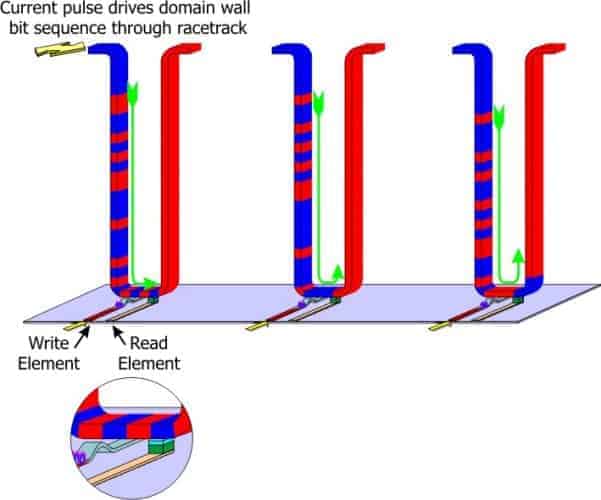Physicists in the US have devised a new technique that brings us one step closer to the possibility of using magnetic nanowires as high-density data storage devices. The technique involves moving magnetic domain walls -- the boundaries between regions of opposite magnetization -- along a nanowire using a much smaller spin-polarized current density than was possible before. The researchers claim that this breakthrough could lead to a new type of magnetic memory with up to 100-times the storage density of existing random-access memories (RAMs) (Science 315 1553).

Magnetic domain walls are narrow boundaries between regions where, for example, the magnetic moments point “up” on one side of the wall and “down” on the other. Domain walls can be moved within a material by applying an external magnetic field or injecting a spin-polarized current.
Some physicists reckon that this motion could be exploited in “racetrack” memories, which could store much more data than today’s RAM devices. In a racetrack memory, data are stored as a sequence of magnetic domains – separated by domain walls — along a nanowire (see figure “Racetrack memory”). Individual bits are stored and retrieved by moving the sequence along the nanowire and across magnetic read and write heads.
If this technology is to succeed, a practical way of using spin-polarized currents to move the domain walls along the nanowire must be found. The key challenge is how to reduce the current density needed to move a domain wall when it is “pinned” by a defect in the wire. At the moment, the current density is too high for use in commercial memory devices.
But now Stuart Parkin and colleagues at IBM’s Almaden Research Centre in the US have found a way to reduce the current density by more than factor of five by exploiting the fact that pinned domain walls have a natural frequency of oscillation. When exposed to a train of current pulses with the right length and separation, the amplitude of oscillation increases until the domain wall breaks free of the defect and moves along the wire.
The required pulses were about one nanosecond in length and Parkin told Physics Web that such pulses could easily be used in a racetrack memory – indeed similar pulses are already used routinely in other memory devices.



